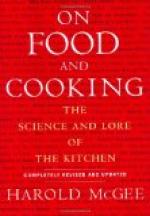A German sitting beside a Spanish officer on board a Havana steamer, was munching Limberger cheese with evident satisfaction when it occurred to him that he ought to offer some to his neighbor, who very coolly declined. “You think it unhealthful to eat that?” inquired the German in polite astonishment. “Unhealthful?” exclaimed the Hidalgo, with a withering look and a gasp for a more adequate word; “No, sir: I think it an unnatural crime!”—Oswald.
Good for Dyspepsia.—“Really, don’t you think cheese is good for dyspepsia?” said an advocate of the use of this common article of food. “Why, my uncle had dyspepsia all his life, and he took a bit of cheese at the close of every meal!”
Mattieu Williams tells us, “When common sense and true sentiment supplant mere unreasoning prejudice, vegetables oils and vegetable fats will largely supplant those of animal origin in every element of our dietary.”
EGGS
As will be seen from the analysis given below, an egg is particularly rich in nitrogenous elements. It is indeed one of the most highly concentrated forms of nitrogenous food, about one third of its weight being solid nutriment, and for this reason is often found serviceable in cases of sickness where it is desirable to secure a large amount of nourishment in small bulk.
Composition of the white of an ordinary hen’s egg.
Nitrogenous matter..................... 20.4 Fatty matter........................... 10.0 Mineral matter......................... 1.6 Water.................................. 68.0
Composition of the yolk.
Nitrogenous matter..................... 1.0 Fatty matter........................... 30.7 Mineral matter......................... 1.3 Water.................................. 52.0
The white of egg is composed mainly of albumen in a dissolved state, inclosed in layers of thin membrane. When beaten, the membranes are broken, and the liberated albumen, owing to its viscous or glutinous nature, entangles and retains a large amount of air, thus increasing to several times its original bulk.
The yolk contains all the fatty matter, and this, with a modified form of albumen called vitellin, forms a kind of yellow emulsion. It is inclosed in a thin membrane, which separates it from the surrounding white.
The yolk, being lighter than the white, floats to that portion of the egg which is uppermost, but is held in position by two membranous cords, one from each end of the egg. The average weight of an egg is about two ounces, of which ten per cent consists of shell, sixty of white, and thirty of yolk.
HOW TO CHOOSE EGGS.—The quality of eggs varies considerably, according to the food upon which the fowls are fed. Certain foods communicate distinct flavors, and it is quite probable that eggs may be rendered unwholesome through the use of filthy or improper food; hence it is always best, when practicable, to ascertain respecting the diet and care of the fowls before purchasing eggs.




